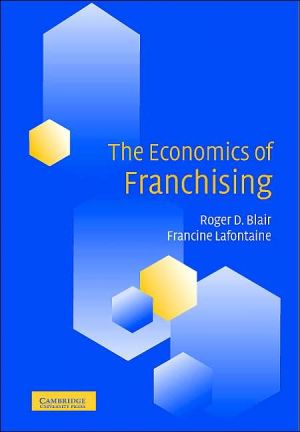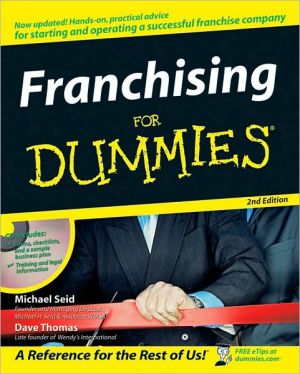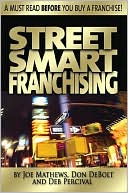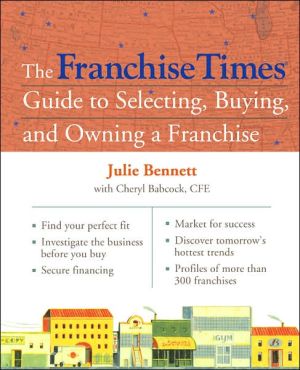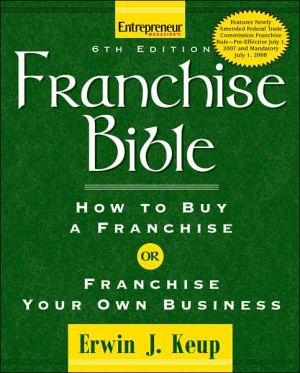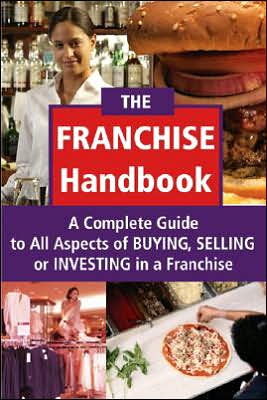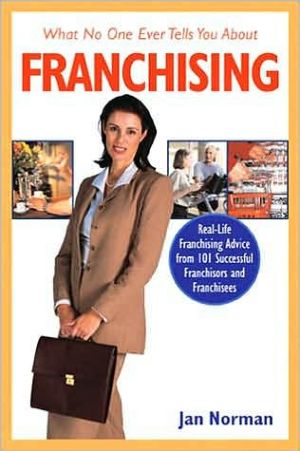Economics of Franchising
This book describes in detail both how and why franchising works. It also analyzes the economic tensions that contribute to conflict in the franchisor-franchisee relationship. The treatment includes a great deal of empirical evidence on franchising, its importance in various segments of the economy, the terms of franchise contracts, and what we know about how all of these have evolved over time, especially in the U.S. market. A good many myths are dispelled in the process. The authors discuss...
Search in google:
This book describes in much detail both how and why franchising works.
\ Cambridge University Press\ 0521772524 - The Economics of Franchising - by Roger D. Blair and Francine Lafontaine\ Excerpt\ \ \ \ \ 1\ Introduction\ \ \ \ Franchising has become a part of everyday life for most consumers in the United States today - it is everywhere. Numerous firms in a variety of industries have adopted franchising as a method of doing business. As a result, consumers now often purchase meals and hotel services along with car repairs, clothing, specialty foods, and many other types of goods and services through franchised companies. Why have so many firms involved in such different activities all chosen to organize themselves as franchised companies? We know that a combination of factors makes franchising desirable. On the one hand, the increased reliance of consumers on brand names, due in part to increased consumer mobility and greater time constraints, has played an important role in the development of retail and other chains.1 In addition, chains can benefit from lower costs through bulk purchasing programs and by realizing economies of scale in production, new product development, and advertising. These benefits, however, really explain why chains have become more prevalent in the economy, not why franchising has become so ubiquitous. After all, the stores in these chains could all be corporately owned, as is the case in many chains. Why then do we see so many other chains organized as franchises? The answer apparently lies in the capacity of franchising to combine the chain's comparative advantages in creating brand recognition and capturing economies of scale with the local entrepreneur's local knowledge and drive.2 In other words, in the ideal franchise relationship, each party is able to specialize in what each does best and yet benefit from the efforts of the other. In fact, as we will see in more detail later, most franchise contracts are written such that both parties share in the sales revenues of the franchised outlet. The contract thus ensures that both parties have incentives to put forth effort to increase those revenues. Such joint incentives are more difficult to achieve in a corporate environment and therein lies the main long-term advantage of franchising over corporate organization.\ The capacity of franchising contracts to harness the effort of a central entity, the franchisor, and of a number of local entrepreneurs, the franchisees, explains in our view much of its current prevalence and popularity as a way of organizing certain economic activities. In particular, franchising is well suited to retailing and service businesses as firms in these sectors need to establish a large number of geographically dispersed outlets to reach customers. In that context, both suppliers of franchises, namely the firms who organize themselves as franchised chains, and the demanders of franchises, that is those individuals eager to develop a small local business, benefit from the interconnection that franchising affords them. Franchisors and their franchisees thus cooperate with one another in a kind of partnership. In many regards, the interests of the franchisor and its franchisees are mutually compatible. Their cooperation increases value for both parties: both earn more profit than they would absent this cooperation.\ In an economic sense, we know that franchising must be efficient as an organizational form since it continues to thrive in competition with other organizational structures.3 In this book, we summarize much of what is known about the economics of franchising. We examine the economic principles that help explain its popularity as a method of distribution, but also highlight how economic principles can shed light on many ways in which franchisor and franchisee needs diverge. These divergent interests create conflict between the franchisor and its franchisees, conflict that undermines the value that cooperation creates. For continued success, this conflict must be minimized. We believe that clearly laying out the sources of conflict is a good first step toward that goal. We therefore devote a substantial portion of this book to the analysis of conflict in franchising. We also devote significant attention to describing franchising and analyzing how it works. In the process, we report data on various aspects of the franchise relationship wherever available and relevant, complementing existing data with new empirical information we derive from a data set on U.S. franchisors that we have built over time from directories. Because our data and our knowledge of applicable law are particular to U.S. franchising, much of our discussion is focused on the way franchising works in this country. This, however, is not as much of a shortcoming as one might suppose. First, we present non-U.S. information whenever we can. More importantly, the general economic principles that we highlight are relevant in all countries and, as will be clear from available data, franchising practices do not differ markedly between countries. Thus, our hope is that the content of this book will prove relevant to anyone with an interest in franchising regardless of where he or she lives and works.\ Before launching into an economic analysis of franchising as an organizational form, we explore a few basics to frame our subsequent analysis. We begin by defining the franchise relationship, distinguishing between traditional and business-format franchising, and identifying the locus and extent of franchising in the U.S. economy. We then describe our data on franchisors, data that we rely on throughout the book. We conclude this introductory chapter by laying out a road map for the remainder of the book.\ \ 1.1 What Is a Franchise?\ According to the American Heritage Dictionary of the English Language, the word franchise comes from the old French word franche, which means free or exempt. In medieval times, a franchise was a right or privilege granted by a sovereign power - king, church, or local government. Sovereigns granted franchises for various activities, such as building roads, holding fairs, organizing markets, or for the right to maintain civil order and collect taxes. In essence, the sovereign gave an individual or group of individuals the monopoly rights over a particular activity in a particular location for a certain period of time. In most cases, the grantee was required to make a payment to the sovereign power for this right or privilege, usually in the form of a share of the product or profit. That payment was called a royalty, a term still in use to this day.\ Today, a franchise agreement is most often understood as a contractual arrangement between two legally independent firms in which one firm, the franchisee, pays the other firm, the franchisor, for the right to sell the franchisor's product and/or the right to use its trademarks and business format in a given location for a specified period of time. But this use of the term franchising in the English language only goes back to the late 1950s: according to Dicke (1992: 2), the word franchise - understood as a method of doing business or distributing goods and services - entered the English business lexicon in 1959. Moreover, governments still grant franchises in certain industries. This occurs, for example, in the cable TV industry in the United States where the rights to be the sole provider of cable services in a given market for a certain time period are sold by local governments to firms usually through what is called a "franchise bidding" process.4 In addition, the word franchise is used in the sports industry to refer to the right to operate a team in a particular locale.5 In this book, however, we focus on the type of franchising that represents an ongoing business relationship between legally independent commercial firms, and accordingly we use the term to mean only such arrangements.\ According to the Federal Trade Commission (FTC), the body that has jurisdiction in the United States over federal disclosure rules for franchisors, three elements must be present for a business relationship to be deemed a franchise.6 First, the franchisor must license a trade name and trademark that the franchisee operates under, or the franchisee must sell products or services identified by this trademark. Second, the franchisor must exert significant control over the operation of the franchisee or provide significant assistance to the franchisee. Third, the franchisee must pay at least $500 to the franchisor at any time before or within the first six months of operation.7 Note that though this definition of franchising is specific to the U.S., most definitions used by authorities outside of the U.S., including Australia, Canada, and the European Union (EU), rely on a similar set of criteria.8 In their implementation, however, foreign definitions are often less inclusive. We come back to this briefly below.\ \ 1.2 Traditional and Business-Format Franchising\ In the U.S., the Department of Commerce (USDOC) historically has distinguished two separate types of franchised relationships: traditional (or product and trade name) franchising and business-format franchising. The former is characterized by franchised dealers who "concentrate on one company's product line and to some extent identify their business with that company" (USDOC 1988: 1). Thus, the Ford dealer, for example, is identified as a distributor of Ford automobiles. As the name suggests, traditional franchising is the oldest form of modern franchising. By most accounts, it can be traced back in the U.S. at least to the mid-1800s when the McCormick Harvesting Machine Company and the Singer Sewing Machines Company sold their products through sales agents who were given exclusive sales territories.9 Initially, these firms, like others who used such agents at the time, imposed few restrictions or qualifications on their agents and exerted very little control over them. Over time, however, both companies found they needed more control over these sales agents if they were to protect their respective reputations and brands. The McCormick Company responded by establishing company-owned branch houses throughout the U.S. and Canada. These branch houses were given oversight responsibilities for the sales agents in their territories. As a result, McCormick was able to systematize procedures and communications with its agents, thereby transforming them into what one would now call "dealers." As for the Singer Company, it addressed the need for control by converting many of the independent agencies into company outlets. More importantly, it devised a series of recommendations for the remaining agents as to how the offices should be run and, for the first time, required detailed financial reporting from these agents. The contracts and methods of control that Singer developed at the time are largely recognized as the forerunners of the modern franchise agreement.10\ Traditional franchising today is comprised largely of automobile dealerships, gasoline service stations, and soft-drink bottlers.11 In all of these businesses, the franchisor is a manufacturer who sells finished or semi-finished products to its dealers/franchisees. In turn, the franchisees resell these products to consumers or other firms in the distribution chain. Because the franchisor's product is sold to its franchisees, the franchisor's profits from its dealer network flow from the markups it earns on these products. In contrast to what occurs in business-format franchising, as described below, traditional franchisees do not pay running royalties on their sales.\ Traditional franchising accounted for 72.7 percent of all sales by franchised chains in 1986, the last year in which the U.S. government collected and published statistics on franchising.12 The remaining 27.3 percent of all franchised sales were generated by business-format franchising firms in which the franchisor primarily sells a way of doing business (i.e., a business format) to its franchisees. A business-format franchise thus "includes not only the product, service, and trademark, but the entire business format itself - a marketing strategy and plan, operating manuals and standards, quality control, and continuing two-way communication" (USDOC 1988: 3).\ The first true business-format franchise system was created by Martha Mathilda Harper (Plitt 2000). This entrepreneur developed her network of Harper Beauty Shops from the early 1890s onward using a business model that included all of the components of a business format as described by the USDOC, and more. But though she grew her network to more than 500 shops in the U.S., Canada, and Europe by the mid-1920s, Mathilda Harper unfortunately did not leave a lasting mark on franchising. Other firms, such as the supermarket chain Piggly Wiggly, Hertz Car Rentals, IGA (Independent Grocers Association), A&W Restaurants, Ben Franklin Retailers, Maid Rite (a hamburger restaurant chain), and Terminix Termite and Pest Control all started franchising in the 1920s and are still franchising today. According to the French Franchise Federation, Jean Prouvost, owner of the Lainière de Roubais, launched his network of Pingouin stores also in the 1920s, thereby initiating the concept of franchised distribution in France.13 These early entrants were followed in the 1930s by companies like Howard Johnson Restaurants, Stewart's Drive-In, Arthur Murray Schools of Dancing, and Culligan in the U.S., and by the Canadian Tire retail chain and its Associate Store program, Merle Norman Cosmetics, and Le Groupe RONA among others in Canada.14 But it was not until the 1950s, with the advent of chains such as Burger King and McDonald's, and the economic boom of the post-World War Ⅱ era, that business-format franchising fully came into its own in the U.S. and Canada, and, even more recently, throughout much of the rest of the world.15\ Business-format franchising today encompasses a very large number of firms that provide a wide array of goods and services: automotive products and services, computer sales, business aids and services, construction and maintenance, legal, domestic, and childcare services, and non-food retailing as well as the more visible hotel, fast-food, and car rental franchises. In exchange for the business format, franchisees typically pay a relatively small lump-sum fixed fee at the beginning of the contract period and pay running royalties that are usually calculated as a fixed percentage of the franchisee's sales revenues.16 Business-format franchisees also often contribute an additional fraction of their sales or revenues toward an advertising fund for the chain as a whole. Presumably, the advertising carried out with these funds benefits all franchisees and thereby benefits the franchisor as well.\ In the end, the distinction between traditional and business-format franchising is somewhat arbitrary and basically a matter of degree. Dnes (1992a) and Klein (1995), for example, both argue that there is little economic difference between the two, in terms of either the type of agreements they rely on or the type of support provided or control exerted by franchisors. And when it comes to theoretical analyses of franchise relationships, the distinction between these two types of franchising indeed is largely irrelevant: researchers have considered both types simultaneously in many studies. But while in theory the distinction may not be so meaningful, it is important from a descriptive standpoint for two main reasons. First, in many countries outside the U.S., traditional franchising is not included in franchising statistics. As a result, the franchising sector appears artificially large in the U.S. relative to these other countries. Second, in the U.S., authors often refer to all franchising when they emphasize its economic importance: after all, sales of goods and services through traditional and business-format franchising together amounted to almost 13 percent of real gross domestic product (GDP) (see Chapter 2), or 34 percent of retail sales, in 1986 according to the USDOC (1988: 14). When presenting data about the growth in franchising in the U.S., however, the data more often measure business-format franchising only. This is because business-format franchising has grown much faster than traditional franchising over the last few decades. Thus, the separation of franchising into two different types has allowed the trade press to mostly emphasize those franchising figures that show franchising in its most favorable light. We return to the issue of franchising growth in the next chapter.\ \ 1.3 In Which Industries Do We Find Franchising?\ As noted by the USDOC (1988: 14), "[r]etailing dominates franchising, accounting for 87 percent of all franchising receipts in 1987. The retail sales of all firms associated with franchising reached about $522 billion in 1987, or 34 percent of all U.S. retail sales, which are estimated at $1.5 trillion."17 Table 1-1 shows the sectoral breakdown for sales, the number of establishments, and employment for franchised firms in the U.S. in 1986 as per the USDOC (1988). It also shows average sales per establishment in each sector.\ Table 1-1 first confirms that sales through traditional franchising are almost three times the level of sales of business-format franchisors. In contrast, the bulk of the establishments and employment are in business-format franchising. The number of establishments is twice as large and the number of employees is almost three times larger in business-format than in traditional franchising. This implies that sales per unit and sales per employee are much larger in traditional than in business-format franchising. This is shown in the last column of Table 1-1, in which sales per establishment for car dealerships and soft-drink bottlers completely overwhelm those of gasoline stations as well as those of every type of business-format franchise. While the government data above all pertain to 1986, a recent report on the economic impact of franchising in the U.S. economy suggests that business-format franchising in 2001 encompassed 4.3 times as many establishments and employed four times as many workers as traditional franchising did.18\ \ Table 1-1: Sales, establishments, and employment in franchising in the U.S. in 1986\ \ \ \ \ \ \ Sales per\ \ \ \ Sales\ Number of\ Number of\ establishment\ \ \ Sector\ ($ thousands)\ establishments\ employees*\ ($ thousands)\ \ \ \ \ Automobile and Truck Dealers\ 307,256,000\ 27,600\ 947,400\ 11,132\ \ \ Gasoline Service Stations\ 86,618,000\ 120,510\ 596,400\ 719\ \ \ Soft-Drink Bottlers\ 19,662,000\ 1,203\ 126,200\ 16,344\ \ \ \ \ All Traditional Franchising\ 413,536,000\ 149,313\ 1,670,000\ 2,770\ \ \ \ Automotive Products and Servicesa\ 11,300,863\ 36,763\ 186,182\ 307\ \ \ Business Aids and Servicesb\ 13,288,254\ 52,718\ 669,522\ 252\ \ \ Construction, Home\ 4,615,360\ 18,900\ 118,991\ 244\ \ \ Improvement, Maintenance,\ \ \ \ \ \ \ and Cleaning Servicesc\ \ \ \ \ \ \ Convenience Stores\ 11,278,895\ 15,524\ 152,688\ 726\ \ \ Educational Products and Servicesd\ 935,166\ 8,625\ 41,210\ 108\ \ \ Hotels, Motels, and Campgrounds\ 15,983,990\ 8,203\ 555,674\ 1,949\ \ \ Laundry and Drycleaning Services\ 291,802\ 2,297\ 9,891\ 127\ \ \ Recreation, Entertainment,\ 3,549,025\ 7,901\ 27,732\ 449\ \ \ and Travele\ \ \ \ \ \ \ Rental Services (Auto-Truck) f\ 6,155,006\ 9,528\ 66,423\ 646\ \ \ Rental Services (Equipment)g\ 716,019\ 2,718\ 14,926\ 263\ \ \ Restaurants\ 52,273,863\ 78,203\ 2,453,621\ 668\ \ \ Retailing (Food\ 10,746,011\ 19,852\ 214,768\ 541\ \ \ Non-Convenience)h\ \ \ \ \ \ \ Retailing (Non-Food)i\ 23,102,779\ 45,456\ 274,663\ 508\ \ \ Miscellaneousj\ 1,305,715\ 6,122\ 44,486\ 213\ \ \ \ All Business-Format Franchising\ 155,542,748\ 312,810\ 4,830,777\ 497\ \ \ \ \ Total Franchising\ 569,078,748\ 462,123\ 6,500,777\ 1,231\ \ \ \ Table 1-1 also illustrates that franchising occurs in a wide variety of retail and service industries in the U.S. economy. Within business-format franchising, the bulk of sales, units, and employees in 1986 were found in the restaurant sector, which includes such well-known chains as Burger King, KFC, Little Caesar's, McDonald's, and Subway, among many others. The next largest sector from a sales perspective was the non-food retailing sector, which includes chains such as The Athlete's Foot, The Body Shop, Decorating Den, and General Nutrition Centers. From an establishment and an employment perspective, however, the second largest business-format franchising sector was the business aids and services sectors, with firms such as Money Mailer, SignFast, and Snelling Personnel Services.\ The data in Table 1-1, however, reflect the sector distribution of franchising activities as it existed in 1986. Unfortunately, since Franchising in the Economy is no longer published by the U.S. government, updated figures corresponding to those in Table 1-1 are unavailable. This lack of data has made it quite difficult to accurately assess how franchising has evolved since the mid-1980s in the United States.19\ \ \ \ \ © Cambridge University Press
1Introduction12Four popular misconceptions about franchising203Franchise contracts544Franchising, vertical integration, and vertical restraints825Quality control1176Franchise tying contracts1397Vertical price controls in franchising1748Encroachment2029Advertising and promotion23610Termination and non-renewal25811Concluding remarks291
